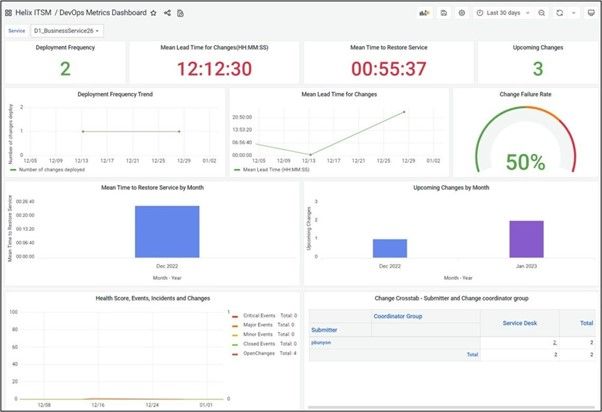The BMC Helix ITSM devOps metrics dashboard, available out of the box with BMC Helix Dashboards, uses industry-standard DevOps Research and Assessment (DORA) metrics to visualize how organizational software development performance impacts a service or application.
In this blog, we will describe this dashboard and discuss how these metrics are a powerful tool for performance optimization, not only for DevOps-driven software delivery, but also for a wider range of agile, incremental, and collaborative IT work.
DevOps Research and Assessment is a long-running industry research program founded by Dr. Nicole Forsgren and Gene Kim, two major pioneers and thought leaders in the enterprise DevOps community. Operating as part of the Google Cloud organization, DORA works to understand the capabilities that drive software delivery and operations performance.
One of the major outputs from the program is identifying a set of four performance metrics that are critical to delivering successful outcomes based on DevOps practices. They are:
- Deployment frequency: For the service or application being worked on, how often does the organization deploy code to production or release it to end users?
- Lead time for changes: How much time elapses between the initial commit of code into the production deployment process and its successful delivery running code in production?
- Time to restore service: How long does it generally take to restore service to users after a defect or an unplanned incident impacts them?
- Change failure rate: What percentage of changes made to a service or application results in impairment or failure of the service and requires remediation?
DevOps Research and Assessment subsequently added an additional category, operational performance, which reflects the reliability and health of the service.
DevOps Research and Assessment metrics in BMC Helix
The BMC Helix ITSM DevOps Metrics Dashboard brings these metrics and more to life, enabling you to visualize current performance, as well as ongoing performance trends, for change activity against a service. In addition to the four key DORA metrics, the dashboard harnesses the best-in-class ServiceOps and AIOps capabilities of BMC Helix to provide an ongoing view of the health of the service.
The dashboard also gives the viewer valuable information about upcoming change activity, as well as additional actionable insights to help drive improvements.

Figure 1. Sample BMC Helix ITSM DevOps Metrics Dashboard.
However, while it is inspired by DevOps Research and Assessment guidelines, the dashboard should not be considered only for DevOps, or code deployment in general. As noted by the DORA website, “These metrics work for any type of technology your organization is delivering”.”
This pairing of expert-driven optimization with reduced friction draws comparisons with ITIL® 4, which shares many of the same guiding principles that have underpinned DevOps throughout its short life: iterative progression with continuous feedback; collaboration and visibility of work; optimization; and automation.
Indeed, “High-Velocity IT” is one of the four key practitioner books in the ITIL® 4 library, and it specifically adapts the learnings of DevOps to the broader IT environment. As the book’s introduction states, “High velocity does not come at the expense of the utility or warranty of the solution, and high velocity equates with high performance in general.”
As such, this dashboard provides value not just to organizations that are active adopters and practitioners of DevOps, but also any technical organization seeking to implement changes more frequently, quickly, and iteratively with greater resilience and automation.
According to the 2022 State of DevOps Report, these benefits are relevant far beyond DevOps: “The faster your teams can make change, the sooner you can deliver value to your customers, run experiments, and receive valuable feedback.”
For more infomation on BMC Helix ITSM, and its capabilities to enhance agility and innovation, visit https://www.bmc.com/it-solutions/bmc-helix-itsm.html.
These postings are my own and do not necessarily represent BMC's position, strategies, or opinion.
See an error or have a suggestion? Please let us know by emailing [email protected].




